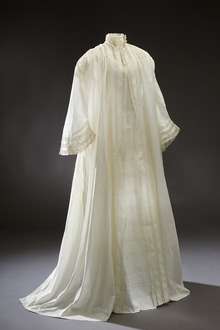Dressing gown
A dressing gown, housecoat or morning gown is a robe, a loose-fitting outer garment, worn by either men or women. They are similar to a bathrobe but without the absorbent material.

A dressing gown or a housecoat is a loose, open-fronted gown closed with a fabric belt that is put on over nightwear on rising from bed, or, less commonly today, worn over some day clothes when partially dressed or undressed in the morning or evening (for example, over a man's shirt and trousers without jacket and tie).
Dressing gowns are typically worn around the house. They may be worn for warmth, as a convenient covering over nightwear when not being in bed, or as a form of lingerie. A dressing gown may be worn over nightwear or other clothing, or with nothing underneath. When guests or other visitors are expected to enter the household while the host(s) are partially dressed or undressed, the hosts may put on additional clothing, such as a dressing gown.
History
The regular wearing of a dressing gown by men about the house is derived from the 18th-century wearing of the banyan in orientalist imitation.[1] The Japanese yukata is an unlined, cotton kimono worn as a bathrobe or as summer outdoor clothing.
See also
References
- In 1888, Coffignon describes it an article of Armenian clothing which started to be worn under Louis XV, "costume arménien qui commença à être porté sous le règne de Louis XV"(Les coulisses de la mode. Paris vivant, p.123. A la librairie illustrée)